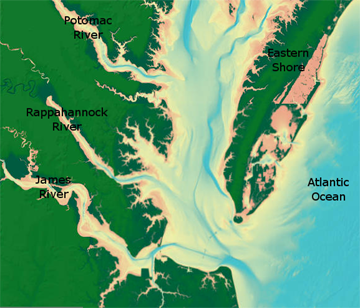It’s been a rough few decades for Chesapeake Bay. Urban development and agriculture have taken away wetlands and polluted the waters. Invasive species have damaged the wetlands even more, and overcome some of the native species. And things may not get much better in the decades ahead, thanks to the rapid rise in sea level.
 Chesapeake Bay bathymetry Credit: National Oceanic and Atmospheric Administration
Chesapeake Bay bathymetry Credit: National Oceanic and Atmospheric AdministrationNot only is the water itself rising, but the land around the Chesapeake is sinking. The combined relative rise in sea level is up to two-tenths of an inch per year, and it’s expected to increase in the decades ahead.
A study looked at what would happen to the bay area if sea level rises by two feet by the end of the century — the minimum rise forecast by most climate scientists.
The study found that the region would lose about 250 square miles of undeveloped land and more than half of its current beaches. Much of the wetlands that support fish, shellfish, and birds would be inundated, damaging the region’s fishing and tourism. And nesting grounds for endangered sea turtles would be threatened as well.
And in cities and towns, rising water levels could cover roadways, and require moving or replacing water and sewer lines. And deeper bay waters would intensify the power of waves produced by storms.
Some of the problems could be lessened by hauling in sediments to build up the coastline and wetlands, and by building barricades around cities and towns. But those are expensive ways — and only temporary ones — to protect a region that’s endangered by the rising seas.

